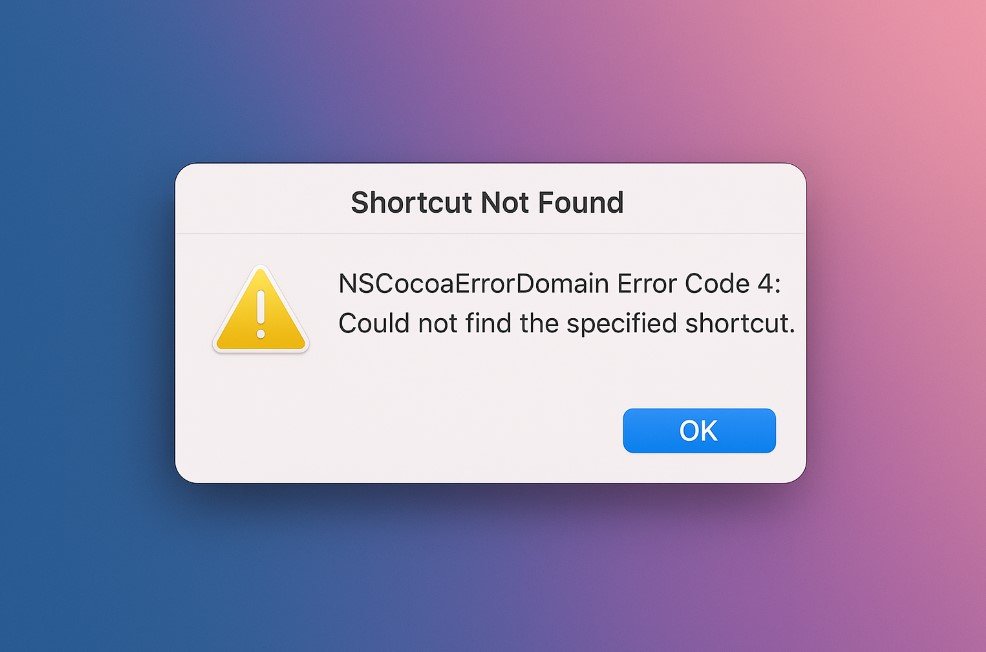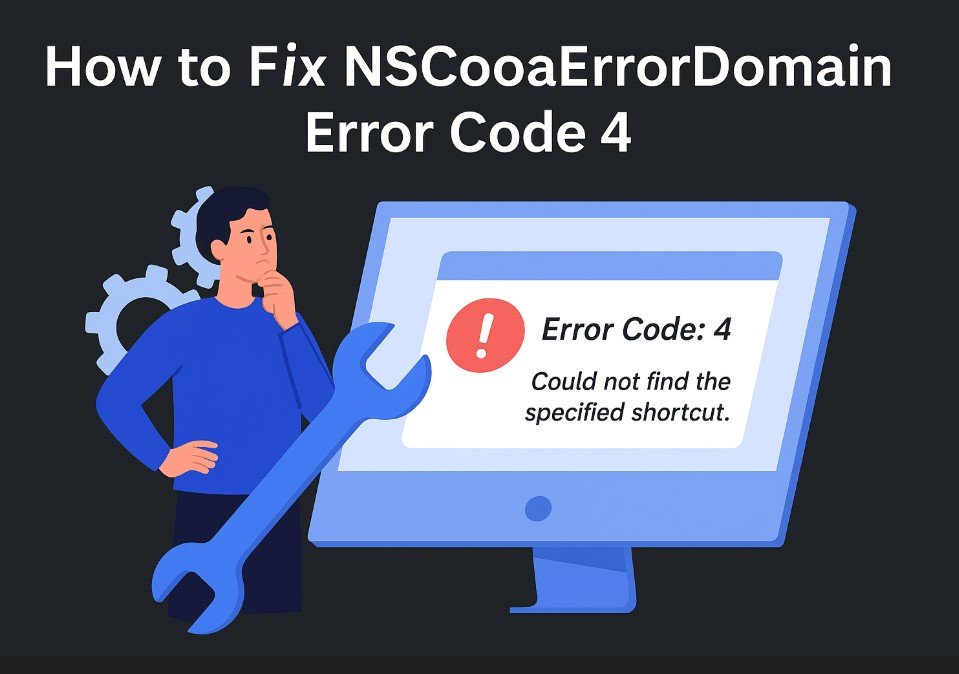Tech
Fix NSCocoaErrorDomain Error Code 4: Shortcut Not Found

If you are using a Mac or an app developed for macOS or iOS and suddenly face an error saying “NSCocoaErrorDomain Error Code 4: Could not find the specified shortcut,” it can be confusing and annoying. This article will help you understand what this error means, what causes it, and how you can fix it. We will also explain step-by-step solutions that work in most situations.
What Is NSCocoaErrorDomain?
Before solving the issue, it is important to understand what NSCocoaErrorDomain is. NSCocoaErrorDomain is a category of errors used by Apple’s Cocoa framework. Cocoa is the foundation of many macOS and iOS applications. If something goes wrong while your app is trying to access a file or shortcut, the system might throw an error under this domain.
Each error within this domain comes with a specific error code. In this case, the error code is 4. This code is associated with the message “The file doesn’t exist,” and that’s why you are seeing this error related to a shortcut that cannot be found.
What Does Error Code 4 Mean?
NSCocoaErrorDomain Error Code 4 specifically means the file, folder, or shortcut you are trying to access is missing or cannot be found at the given location. The system was expecting something to be there, but it isn’t.
Common Causes of This Error
Here are some common reasons why you might get this error:
- The shortcut was deleted.
- The file was moved to a different location.
- The file path is incorrect.
- The file name contains invalid characters.
- The app or script that is trying to access the file is outdated or misconfigured.
Where Do You Usually See This Error?
You may see this error in the following situations:
- When using Apple Shortcuts on macOS or iOS.
- While opening a file through a third-party app.
- During scripting in macOS using AppleScript or Automator.
- When an app tries to access a resource that has been renamed or removed.
- While working with development tools such as Xcode.
Now that we know what the error is and what causes it, let’s look at how to fix it.
How to Fix NSCocoaErrorDomain Error Code 4

-
Check if the File or Shortcut Exists
The most basic step is to check if the file or shortcut still exists in its original location. If it was deleted or moved, you will need to recreate it or change the path to the new location.
Steps:
- Open Finder.
- Go to the original file path or the folder.
- See if the file or shortcut is there.
- If not, check the Trash or use the search function.
-
Correct the File Path
If you are referencing a file through a script or app, make sure the file path is correct. A small mistake in the path will cause this error.
Steps:
- Right-click the file in Finder and select “Get Info.”
- Copy the full path.
- Replace the incorrect path in your app, script, or configuration file with the correct one.
-
Recreate the Shortcut
If the shortcut was deleted or corrupted, you can simply create a new one.
Steps:
- Locate the original file or folder.
- Right-click on it.
- Choose “Make Alias.”
- Move the alias (shortcut) to the original location expected by the app or script.
-
Check App Settings
Some apps allow you to define where your files or shortcuts are stored. If that setting is pointing to an old or wrong location, change it.
Steps:
- Open the app.
- Go to Preferences or Settings.
- Check file or folder paths.
- Update the path if needed.
-
Use Terminal to Confirm File Existence
Sometimes files are hidden or have unusual permissions. You can use Terminal to check if the file really exists.
Steps:
- Open Terminal.
- Type
lsfollowed by the full file path. - If the file is listed, it exists.
- If not, you may have the wrong path, or the file may be deleted.
Example:
ls /Users/username/Documents/myfile.txt
-
Check File Permissions
macOS might prevent apps from accessing certain files or folders due to privacy settings or file permissions.
Steps:
- Right-click on the file or folder.
- Choose “Get Info.”
- Scroll to “Sharing & Permissions.”
- Make sure your user account has “Read & Write” access.
- Click the lock icon to make changes if needed.
-
Reinstall the Application
If the error keeps happening within a specific app, it might be corrupted. Reinstalling the app could fix the issue.
Steps:
- Go to Finder > Applications.
- Drag the app to the Trash.
- Empty the Trash.
- Re-download and install the app from the official source.
-
Clear Cache and Temporary Files
Cached or temporary files can sometimes cause this error if they are pointing to old or missing locations.
Steps:
- Open Finder.
- Press Command + Shift + G.
- Type
~/Library/Caches/and press Enter. - Delete the cache folder related to the app causing the error.
-
Reset System Shortcuts
If the problem is with macOS Shortcuts, you can reset or remove the problematic shortcut and create a new one.
Steps:
- Open the Shortcuts app.
- Find the shortcut that is causing the issue.
- Delete it.
- Create a new shortcut with the correct settings.
-
Contact App Support or Apple Support
If none of the above methods work, you may need expert help. Contact the support team of the app or reach out to Apple Support for deeper troubleshooting.
Prevention Tips
- To avoid facing this error in the future, here are a few tips:
- Do not move or delete files that are linked to apps or shortcuts.
- Use proper file naming without special characters.
- Backup your shortcuts and configurations.
- Regularly update your apps and macOS to the latest version.
Sample Error Explained
Sometimes you may come across an error that looks like this:
errordomain=nscocoaerrordomain&errormessage=could not find the specified shortcut.&errorcode=4
This long line contains all the technical parts of the error:
errordomain=nscocoaerrordomaintells you the category of the error.errormessage=could not find the specified shortcut.It is a plain description.errorcode=4is the code that tells developers and support teams what the exact issue is.
This format may be displayed in logs, developer tools, or app error reports.
Final Thoughts
NSCocoaErrorDomain Error Code 4 is a common but fixable error that occurs when the system or app cannot find a file or shortcut. By checking the file path, recreating the shortcut, updating app settings, or resetting permissions, you can solve this issue in most cases.
Always make sure that your files and shortcuts are properly placed and not removed or renamed without updating related scripts or apps. This small attention to detail can save you from a lot of trouble.
If you continue to face the error and cannot figure it out, contacting support may be the best solution. In most cases, however, following the steps in this article will help you fix the problem easily and get back to work.
-

 Social Media2 months ago
Social Media2 months agoWhat the “67” TikTok Meme Really Means
-

 Tech2 months ago
Tech2 months agoWhat To Do When Your Business Faces Network Vulnerabilities
-

 Self Improvement2 months ago
Self Improvement2 months agoUsing BCBS Rehab to Access Quality Addiction Care
-

 Games2 months ago
Games2 months agoPusoy Strategies for Play That Also Work in Pusoy Dos in English






